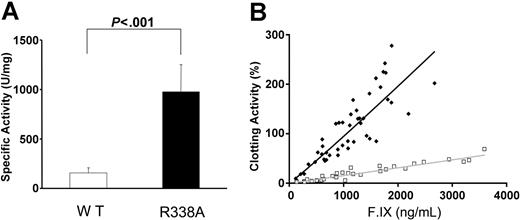Abstract
Intramuscular injection of adeno-associated viral (AAV) vector to skeletal muscle of humans with hemophilia B is safe, but higher doses are required to achieve therapeutic factor IX (F.IX) levels. The efficacy of this approach is hampered by the retention of F.IX in muscle extracellular spaces and by the limiting capacity of muscle to synthesize fully active F.IX at high expression rates. To overcome these limitations, we constructed AAV vectors encoding F.IX variants for muscle- or liver-directed expression in hemophilia B mice. Circulating F.IX levels following intramuscular injection of AAV-F.IX-K5A/V10K, a variant with low-affinity to extracellular matrix, were 2-5 fold higher compared with wild-type (WT) F.IX, while the protein-specific activities remained similar. Expression of F.IX-R338A generated a protein with 2- or 6-fold higher specific activity than F.IX-WT following vector delivery to skeletal muscle or liver, respectively. F.IX-WT and variant forms provide effective hemostasis in vivo upon challenge by tail-clipping assay. Importantly, intramuscular injection of AAV-F.IX variants did not trigger antibody formation to F.IX in mice tolerant to F.IX-WT. These studies demonstrate that F.IX variants provide a promising strategy to improve the efficacy for a variety of gene-based therapies for hemophilia B.
Introduction
Hemophilia B is an X-linked bleeding disorder characterized by a deficiency of coagulation factor IX (F.IX). The disease is an excellent candidate for gene-based therapy because low levels of F.IX (1%-5% of normal) have been shown to substantially reduce the frequency of spontaneous bleeds.1,2 F.IX is the zymogen of a serine protease that undergoes extensive posttranslation modifications in the liver, the normal site of production, to achieve full biologic activity.3 From a gene transfer perspective, there are a variety of target tissues besides the liver for F.IX gene transfer, including skeletal muscle,4 keratinocytes,5 endothelial cells,6,7 fibroblasts,6,8 gut,9 and bone marrow stroma cells,10 provided that the protein can be secreted into the circulation.
We demonstrated that introduction of an adeno-associated viral (AAV) vector encoding F.IX into skeletal muscle can result in long-term expression of therapeutic levels of F.IX in mice and hemophilia B dogs.4,11 In humans subjects with severe hemophilia B, we showed that intramuscular injection of AAV-F.IX at doses tested was safe, but F.IX levels were subtherapeutic.12 To increase the vector dose would require hundreds of injection sites because the risk for inhibitors to F.IX increases as the vector dose and/or antigen (F.IX) synthesized per site increase.13,14 Moreover, inadvertent biodistribution of vector to nontarget tissue is also a limiting factor for safety.15,16 Thus, it is fundamental to develop strategies that improve gene transfer efficacy without simply increasing the vector dose.
Skeletal muscle biopsy of AAV-injected mice, hemophilia B dogs, or human subjects revealed that F.IX accumulates intracellularly and also extensively in the extracellular space.4,11,12 In mice, we have demonstrated that F.IX staining colocalizes with collagen IV,11 which is regarded as a natural binding site for F.IX in the extracellular matrix,17,18 a finding also observed in muscle biopsy of humans from the AAV-F.IX clinical study (K. A. High and C. S. Manno, unpublished observations, May 2004). F.IX and activated F.IX (F.IXa) bind to collagen IV on the surface of endothelial cells. This interaction occurs through F.IX residues 3 to 11 in the γ-carboxyglutamic acid (Gla) domain. Substitutions within the F.IX Gla domain at lysine 5 to alanine (K5A) or valine 10 to lysine (V10K) resulted in F.IX with no measurable affinity for endothelial cells/collagen IV but, importantly, retained normal clotting activity.17,18 Thus, we hypothesized that introduction of these variants into AAV-F.IX would optimize the release of F.IX into the circulation.
Previous studies demonstrated that the substitution R338A in the F.IX catalytic domain resulted in a molecule with 3-fold higher specific activity than F.IX-wild type (WT).19 A series of in vitro experiments determined that this residue is part of an extended macromolecular binding site, which may be more accessible to factor X when F.IXa binds factor VIIIa. Thus, the use of this variant may optimize the biologic activity of F.IX synthesized per transduced cell.
Here, we report that intramuscular injection of AAV vectors encoding the F.IX double variant K5A/V10K results in high circulating levels of F.IX without compromising the protein activity. The use of the variant F.IX-R338A generates a protein with 2- or 6-fold higher specific activity than F.IX-WT, when delivered to skeletal muscle or liver, respectively. Although liver- and muscle-synthesized F.IX of all forms provides effective hemostasis in a tail-clipping assay, the variant R338A was the most effective. Importantly, intramuscular injection of AAV-F.IX variants does not trigger antibody formation to F.IX in animals tolerant to F.IX-WT. These studies demonstrate that the use of F.IX variants is an attractive alternative to improve phenotypic correction of hemophilia B. Their use might have implications for a variety of viral and nonviral vector strategies targeting liver or tissues rich in collagen IV.
Materials and methods
Generation of F.IX variants
Nucleotide substitutions K5A (AAA>GCC), V10K (GTT>AAA), or R338A (CGA>GCA) were introduced with the QuickChange Site-Directed Mutagenesis Kit (Stratagene, La Jolla, CA). All cDNA fragments containing mutations were sequenced before vector construction.
Production of AAV vectors
Recombinant AAV-1 and AAV-2 vectors were produced as previously described.14,20 The plasmids encoding F.IX-WT or variants were under the control of the cytomegalovirus (CMV) promoter/enhancer (for muscle experiments) or the human alpha-1 antitrypsin promoter and 4 copies of apolipoprotein A enhancer (hAAT/ApoE) for liver-specific gene transfer.21 AAV vectors were purified by repeated cesium chloride density gradient centrifugation, and the vector titers were determined by quantitative dot-blot hybridization.
Animal experiments
Animal procedures were approved by the Institutional Animal Care and Use Committee. Animals used for the experiments included the following: (1) immunodeficient Rag-1 or CD4 knock-out mice (The Jackson Laboratories, Bar Harbor, ME); (2) hemophilia B (F.IX knock out) mice; (3) hemophilia B mice crossed with CD4 knock-out mice; and (4) transgenic mice, on a mixed background, expressing human F.IX from keratinocytes.22 All other animals were on C57Bl/6 background.
A dose-response study was carried out in male Rag-1 mice (6-8 weeks old). Animals (n = 32) received AAV-1 vectors encoding F.IX-WT or F.IX variants at vector doses of 2 × 1011 vector genomes per kg (vg/kg) or 1.2 × 1012 vg/kg. Hemophilia B/CD4 mice (10-14 weeks old) were intramuscularly injected with AAV-1 vectors encoding F.IX-WT (n = 15), F.IX-K5A/V10K (n = 11), or F.IX-R338A (n = 8), and F.IX-specific activity was determined. Vectors were injected into 6 intramuscular sites of the hind limb.
For the liver-directed approach, hemophilia B mice (8-12 weeks old) were tail-vein injected with AAV-2 vectors encoding F.IX-WT (n = 17) or F.IX-R338A (n = 15) at doses ranging from 8 × 1010 vg/kg to 1.2 × 1013 vg/kg.
Transgenic mice for keratinocyte-derived human F.IX-WT (n = 10) receive intramuscular injections of AAV vectors encoding F.IX variants or F.IX-WT at doses of 1 × 1012 vg/kg. Because these animals were 12 months or older, we also injected age-matched control groups consisting of normal C57Bl/6 mice (n = 3) and CD4-deficient mice (n = 3).
Clotting assays, F.IX antigen, and antibody to F.IX
F.IX concentration was determined using an enzyme-linked immunosorbent assay (ELISA) in which a monoclonal antibody to human F.IX, clone HIX-1 (Sigma, St Louis, MO), was used as capture antibody at dilution of 1:800; and as detecting antibody, peroxidase-conjugated polyclonal goat anti-human F.IX (Affinity Biologicals, Hamilton, ON) was used at dilution of 1:1000. F.IX functional activity was determined by a modified one-stage factor assay incubating 50 μL human F.IX-deficient plasma with 50 μL automated activated partial thromboplastin time (aPTT) reagent (Organon Teknika, Durham, NC), and a total of 50 μL of a test sample that was undiluted (or when required, samples were diluted in imidazole buffer for 3 minutes at 37°C). Then, 50 μL 25-mM CaCl2 was added, and time to clot formation was measured using a fibrometer. F.IX-specific activity was calculated by dividing the clotting activity by the antigen levels and expressed as unit per milligram. Antibodies to F.IX were measured by a specific ELISA to murine immunoglobulin G (IgG) subclasses (IgG1 and IgG2) as described before,23 with minor modifications by coating plates with 1 μg/mL purified recombinant F.IX-WT (Genetic Institutes, Cambridge, MA) or F.IX variants (K5A or R338A).19,24 Thrombin-antithrombin (TAT) complexes were measured by ELISA (Enzygnost TAT) purchased from Behring (Marburg, Germany). This immunoassay developed to detect human TAT presents high cross-reactivity to murine thrombin generation.25
Tail-bleeding time assays
Tail-bleeding times were performed blinded to the injected AAV vector. Mice were anesthetized and distal tail (2.5-3 mm of diameter) was cut and immediately immersed in 37°C saline. Bleeding time measurements exceeding 10 minutes were stopped by suture of the tail. The blood loss was determined by measuring the absorbance of hemoglobin (A575 nm) in the saline solution in which the tail was placed, as reported.26
Reverse-transcriptase-polymerase chain reaction (RT-PCR) for F.IX expression in AAV-injected mice
Mice treated with AAV-CMV-F.IX were killed at week 18 to determine the sites of F.IX expression. Total RNA was isolated from injected skeletal muscle (tibialis anterior and quadriceps) and other tissues as previously described.27
Histochemical analysis
Muscle biopsies were performed at 14 weeks after vector injection. For muscle tissue, serial cryosections (5-10 μm) were obtained, and F.IX expression was visualized by immunofluorescence staining using 1:400 dilution of goat anti-human F.IX antibody, and for detection, anti-goat IgG fluorescein-conjugated antibody at dilution of 1:10 000 (Dako, Carpinteria, CA). Stained sections were viewed with an Eclipse E800 microscope (Nikon, Tokyo, Japan) using a Plan Apo × 20/0.75 objective and epifluorescent light (FITC HYQ filter). Images were captured with a CoolSNAP Pro camera and analyzed with Image Pro Plus software (Media Cybernetics, Silver Spring, MD).
DNA analysis
A total of 20 μg genomic DNA extracted from injected muscle at week 14 was digested with endonuclease EcoRV, separated in a 1% agarose gel, and transferred to a nylon positively charged membrane (Amersham Pharm Biotech, Little Chalfont, England). Southern blot hybridization was performed with a random-primed labeled probe (1.2 kilobase [kb]) to intron 1 of F.IX using α-32P-deoxycytidine triphosphate and the Prime It II kit (Stratagene). Vector genomes were identified as a 1.7-kb band, as reported.11 Intensity of bands on autoradiographs was quantitated by densitometric scanning of the exposed X-ray film (http://rsb.info.nih.gov/nih-image/).
Statistical analysis
Comparison of data obtained from distinct experimental groups was analyzed by unpaired Student t test or analysis of variance (ANOVA), using JMP version 4.0.2 (SAS Institute, Cary, NC).
Results
Intramuscular injection of AAV-1 vectors encoding F.IX variant K5A/V10K result in high circulating F.IX levels
Immunodeficient mice (Rag-1) were intramuscularly injected at doses of 2 × 1011 vg/kg or 1.2 × 1012 vg/kg (n = 4 mice/group) with AAV vectors expressing F.IX variants and compared with F.IX-WT. These vectors differ only in the F.IX sequence containing substitutions (Figure 1) at position 5 (K5A) alone or in combination with V10K (K5A/V10K) or R338A.
Vector design. (A) Skeletal muscle-directed gene transfer: The expression cassette contains the CMV enhancer/promoter, the simian virus 40 (SV40) polyadenylation signal, and is flanked by the AAV-2 inverted terminal repeats (ITRs). The human transgene contains cDNA of exon 1 from the human F.IX gene as WT or variants (K5A or K5A/V10K) interrupted by a 1.4-kb fragment of F.IX intron I, and exons 2 to 8 of the F.IX-WT or variant (R338A). The substitutions introduced in the mature F.IX sequence are indicated. (B) Liver-directed gene transfer: The expression cassette contains the human α1-antitrypsin promoter coupled to the human apolipoprotein E enhancer, exon 1 from the human F.IX gene, a truncated human F.IX intron 1, exons 2 to 8 of the F.IX gene WT or variant (R338A), and the bovine growth hormone polyadenylation signal sequence. The expression cassette is flanked by ITRs derived from AAV type 2.
Vector design. (A) Skeletal muscle-directed gene transfer: The expression cassette contains the CMV enhancer/promoter, the simian virus 40 (SV40) polyadenylation signal, and is flanked by the AAV-2 inverted terminal repeats (ITRs). The human transgene contains cDNA of exon 1 from the human F.IX gene as WT or variants (K5A or K5A/V10K) interrupted by a 1.4-kb fragment of F.IX intron I, and exons 2 to 8 of the F.IX-WT or variant (R338A). The substitutions introduced in the mature F.IX sequence are indicated. (B) Liver-directed gene transfer: The expression cassette contains the human α1-antitrypsin promoter coupled to the human apolipoprotein E enhancer, exon 1 from the human F.IX gene, a truncated human F.IX intron 1, exons 2 to 8 of the F.IX gene WT or variant (R338A), and the bovine growth hormone polyadenylation signal sequence. The expression cassette is flanked by ITRs derived from AAV type 2.
Circulating F.IX levels were similar between F.IX-WT or F.IX-R338A mice for vector doses tested (Figure 2), as expected. However, the variant K5A resulted in an approximately 2-fold increase in circulating F.IX levels compared with F.IX-WT treated mice, but only in the high-dose cohort. Because previous in vitro experiments demonstrated that F.IX-K5A or -V10K presented comparable binding affinity to collagen IV,18 we did not pursue F.IX-V10K alone as an alternative to F.IX-K5A but rather combined both in the same transgene. The results demonstrated that the variant F.IX-K5A/V10K resulted in 2-fold higher circulating levels (451 ± 120 ng/mL) compared with other F.IX forms, at low vector dose. Further increase in the dose demonstrated the superiority of F.IX-K5A/V10K, which resulted in 3- to 5-fold higher circulating F.IX levels compared with F.IX-WT (P ≤ .002) throughout the duration of the experiment (Figure 2B). These suggest that both mutations (K5A/V10K) are required for a significant increase in circulating F.IX levels.
Time course of human F.IX expression in C57Bl/6 Rag-1 knock-out mice. Mice were injected into skeletal muscle with AAV-1 vectors encoding F.IX-WT ( ), the F.IX variants K5A (
), the F.IX variants K5A ( ), K5A/V10K (▴), or R338A (▪). Vector was injected at doses of 2 × 1011 vg/kg (A) or 1.2 × 1012 vg/kg (B) at 6 intramuscular sites in the hind limbs. Each line represents average values for the cohort (n = 4 mice). Markers represent mean values (± SD). *P ≤ .002 and **P ≤ .05 of comparison between F.IX-WT and F.IX-K5A/V10K groups.
), K5A/V10K (▴), or R338A (▪). Vector was injected at doses of 2 × 1011 vg/kg (A) or 1.2 × 1012 vg/kg (B) at 6 intramuscular sites in the hind limbs. Each line represents average values for the cohort (n = 4 mice). Markers represent mean values (± SD). *P ≤ .002 and **P ≤ .05 of comparison between F.IX-WT and F.IX-K5A/V10K groups.
Time course of human F.IX expression in C57Bl/6 Rag-1 knock-out mice. Mice were injected into skeletal muscle with AAV-1 vectors encoding F.IX-WT ( ), the F.IX variants K5A (
), the F.IX variants K5A ( ), K5A/V10K (▴), or R338A (▪). Vector was injected at doses of 2 × 1011 vg/kg (A) or 1.2 × 1012 vg/kg (B) at 6 intramuscular sites in the hind limbs. Each line represents average values for the cohort (n = 4 mice). Markers represent mean values (± SD). *P ≤ .002 and **P ≤ .05 of comparison between F.IX-WT and F.IX-K5A/V10K groups.
), K5A/V10K (▴), or R338A (▪). Vector was injected at doses of 2 × 1011 vg/kg (A) or 1.2 × 1012 vg/kg (B) at 6 intramuscular sites in the hind limbs. Each line represents average values for the cohort (n = 4 mice). Markers represent mean values (± SD). *P ≤ .002 and **P ≤ .05 of comparison between F.IX-WT and F.IX-K5A/V10K groups.
A dose-dependent increase in F.IX levels was seen for all animals, albeit at different rates (Figure 2). A 5-fold increase in the vector dose resulted in a corresponding 5-fold increase in mean F.IX levels in mice injected with AAV vectors encoding variants K5A (150 ng/mL vs 810 ng/mL) or K5A/V10K (430 ng/mL vs 2250 ng/mL). Whereas similar increase in vector dose resulted in only 2-fold increase in F.IX levels following intramuscular injection of F.IX-WT or R338A.
High circulating F.IX levels result from lesser affinity of F.IX-K5A/V10K to extracellular space structures and not from differences in gene transfer
To ensure that increased circulating levels of F.IX resulted from lower affinity of F.IX-K5A/V10K to the extracellular space, and not due to differences in the gene transfer to the target tissue, we determined the vector gene copy number per cell of the injected muscles. Mice were injected at doses of 5 × 109 vg/injection site for either F.IX-WT or K5A/V10K into 1 site per tibialis anterior and 2 sites per quadriceps of each limb. Southern blot analysis (Figure 3A) revealed no difference in the gene copy number in genomic DNA extracted from injected muscle, as summarized in Table 1.
Vector gene copy number and histochemical staining of skeletal muscle of C57Bl/6 Rag-1-deficient mice 14 weeks following injection of AAV vectors encoding F.IX-WT or variant K5A/V10K. (A) Southern blot analysis of genomic DNA extracted from murine skeletal muscle injected with AAV-F.IX-WT or F.IX-K5A/V10K at the doses indicated. Copy number standards were prepared by adding 3.5, 35, and 350 copies of plasmid per murine diploid genomes. (B) Immunofluorescent staining for human factor IX in tibialis anterior muscle. Animals were injected in the hind limbs with 1.2 × 1012 vg/kg AAV-F.IX-WT or K5A/V10K divided equally among 6 injection sites. Representative sections from the injected muscle are shown. Excitation of fluorescence tags revealed both intracellular and extracellular signals in muscle injected with F.IX-WT, but markedly reduced extracellular signals in muscle injected with F.IX-K5A/V10K, while intracellular signals are clearly detectable. Original magnifications, × 200.
Vector gene copy number and histochemical staining of skeletal muscle of C57Bl/6 Rag-1-deficient mice 14 weeks following injection of AAV vectors encoding F.IX-WT or variant K5A/V10K. (A) Southern blot analysis of genomic DNA extracted from murine skeletal muscle injected with AAV-F.IX-WT or F.IX-K5A/V10K at the doses indicated. Copy number standards were prepared by adding 3.5, 35, and 350 copies of plasmid per murine diploid genomes. (B) Immunofluorescent staining for human factor IX in tibialis anterior muscle. Animals were injected in the hind limbs with 1.2 × 1012 vg/kg AAV-F.IX-WT or K5A/V10K divided equally among 6 injection sites. Representative sections from the injected muscle are shown. Excitation of fluorescence tags revealed both intracellular and extracellular signals in muscle injected with F.IX-WT, but markedly reduced extracellular signals in muscle injected with F.IX-K5A/V10K, while intracellular signals are clearly detectable. Original magnifications, × 200.
Typical staining for F.IX in skeletal muscle injected with AAV-F.IX-WT is represented in Figure 3B. Note that at the injection site, bright intracellular staining for F.IX is surrounded by bright F.IX signal in extracellular spaces. In contrast, with K5A/V10K, a similar intracellular pattern is observed but with markedly reduced, albeit not absent, extracellular staining for F.IX. Together, these data support that elevated circulating F.IX levels result from defective binding to the extracellular matrix and not by differences in local gene transfer.
F.IX variants K5A/V10K or R338A result in improved specific activity of muscle-synthesized F.IX
For these experiments, hemophilia B mice were crossed with CD4-deficient mice. These animals allow detection of F.IX antigen and clotting activity without risk of antibody to the human transgene product. Animals were intramuscularly injected with AAV vectors expressing F.IX-WT (n = 15) or R338A (n = 8) at doses of 4 × 1012 vg/kg or 8 × 1012 vg/kg. AAV-K5A/V10K was injected at doses of 2 × 1011 vg/kg (n = 4), 1.2 × 1012 vg/kg (n = 4), or 4 × 1012 vg/kg (n = 3).
To ensure that F.IX-specific activity represents muscle-synthesized protein, we determined F.IX expression in all major tissues. RT-PCR assay in tissues harvested 14 weeks after vector injection demonstrates that the majority of the transgene is derived from skeletal muscle (Figure 4B). Since F.IX expression levels increased over time, we were able to calculate F.IX-specific activity for a range of transgene expression levels after vector administration (Figure 4A).
Specific activity of F.IX-WT, F.IX-K5A/V10K, and F.IX-R338A following intramuscular injection of AAV vectors to C57Bl/6 hemophilia B/CD4 knock-out mice. (A) F.IX activity is determined in one-stage activated partial thromboplastin assay in mice plasma, and F.IX antigen levels are determined by ELISA. Animals were injected at 6 intramuscular sites in the hind limbs with AAV-F.IX-WT (▦;n = 15) or -R338A ( ; n = 8) at doses of 4 × 1012 vg/kg or 8 × 1012 vg/kg. AAV-K5A/V10K (▵) was injected at doses of 2 × 1011 vg/kg (n = 4), 1.2 × 1012 vg/kg (n = 4), or 4 × 1012 vg/kg (n = 3). Plasma samples were collected at several time points after vector administration, and results from individual animals are indicated. (B) Factor IX expression in murine tissues harvested at week 18 following injection of an AAV vector under the control of the CMV enhancer/promoter. Shown are RT-PCR products for human factor IX sequences and for the murine hypoxanthine phosphoribosyltransferase (HPRT) as housekeeping gene. Gastrointestinal (GI) tract includes tissues from esophagus, stomach, and intestines. Densitometric analysis of RT-PCR shows that the majority of F.IX expression is derived from skeletal muscle and only a small fraction from the liver.
; n = 8) at doses of 4 × 1012 vg/kg or 8 × 1012 vg/kg. AAV-K5A/V10K (▵) was injected at doses of 2 × 1011 vg/kg (n = 4), 1.2 × 1012 vg/kg (n = 4), or 4 × 1012 vg/kg (n = 3). Plasma samples were collected at several time points after vector administration, and results from individual animals are indicated. (B) Factor IX expression in murine tissues harvested at week 18 following injection of an AAV vector under the control of the CMV enhancer/promoter. Shown are RT-PCR products for human factor IX sequences and for the murine hypoxanthine phosphoribosyltransferase (HPRT) as housekeeping gene. Gastrointestinal (GI) tract includes tissues from esophagus, stomach, and intestines. Densitometric analysis of RT-PCR shows that the majority of F.IX expression is derived from skeletal muscle and only a small fraction from the liver.
Specific activity of F.IX-WT, F.IX-K5A/V10K, and F.IX-R338A following intramuscular injection of AAV vectors to C57Bl/6 hemophilia B/CD4 knock-out mice. (A) F.IX activity is determined in one-stage activated partial thromboplastin assay in mice plasma, and F.IX antigen levels are determined by ELISA. Animals were injected at 6 intramuscular sites in the hind limbs with AAV-F.IX-WT (▦;n = 15) or -R338A ( ; n = 8) at doses of 4 × 1012 vg/kg or 8 × 1012 vg/kg. AAV-K5A/V10K (▵) was injected at doses of 2 × 1011 vg/kg (n = 4), 1.2 × 1012 vg/kg (n = 4), or 4 × 1012 vg/kg (n = 3). Plasma samples were collected at several time points after vector administration, and results from individual animals are indicated. (B) Factor IX expression in murine tissues harvested at week 18 following injection of an AAV vector under the control of the CMV enhancer/promoter. Shown are RT-PCR products for human factor IX sequences and for the murine hypoxanthine phosphoribosyltransferase (HPRT) as housekeeping gene. Gastrointestinal (GI) tract includes tissues from esophagus, stomach, and intestines. Densitometric analysis of RT-PCR shows that the majority of F.IX expression is derived from skeletal muscle and only a small fraction from the liver.
; n = 8) at doses of 4 × 1012 vg/kg or 8 × 1012 vg/kg. AAV-K5A/V10K (▵) was injected at doses of 2 × 1011 vg/kg (n = 4), 1.2 × 1012 vg/kg (n = 4), or 4 × 1012 vg/kg (n = 3). Plasma samples were collected at several time points after vector administration, and results from individual animals are indicated. (B) Factor IX expression in murine tissues harvested at week 18 following injection of an AAV vector under the control of the CMV enhancer/promoter. Shown are RT-PCR products for human factor IX sequences and for the murine hypoxanthine phosphoribosyltransferase (HPRT) as housekeeping gene. Gastrointestinal (GI) tract includes tissues from esophagus, stomach, and intestines. Densitometric analysis of RT-PCR shows that the majority of F.IX expression is derived from skeletal muscle and only a small fraction from the liver.
The comparison between F.IX-WT and variant forms was possible after grouping animals with similar levels of F.IX antigen (Table 2). At circulating F.IX levels up to 500 ng/mL, no difference in the specific activity of the transgene products was observed between F.IX-WT (123 ± 15 U/mg) and F.IX-K5A/V10K (112 ± 16 U/mg). However, specific activity of F.IX-R338A was 2.5- to 3-fold higher (305 ± 48 U/mg) compared with F.IX-WT or K5A/V10K (P < .0001), respectively. Further increase in F.IX levels was associated with significant diminution in the specific activity for all F.IX-WT and variants (Figure 4A and Table 2). For animals expressing F.IX levels higher than 500 ng/mL, F.IX-K5A/V10K resulted in a protein with 3-fold higher specific activity when compared with F.IX-WT, but not to R338A (Table 2). This suggested that at high levels of expression, muscle has limited capacity of performing F.IX essential posttranslation modifications, which is more evident in animals expressing F.IX-WT.
Table 3 shows the relative data for comparison among vectors, transgene expression, and clotting activity. The vector doses administered to achieve F.IX levels of approximately 200 ng/mL were 4-fold lower for K5A/V10K compared with F.IX-WT, but results in similar F.IX clotting activity. At comparable circulating F.IX levels, the injection of R338A resulted in a protein with 2-fold higher specific activity. TAT complex levels, a marker of clotting activation, were measured in all animals before and after AAV injection (Table 3). Comparing with baseline values, TAT levels increased 3-fold for FIX-WT-and K5A/V10K-injected mice, whereas for F.IX-R338A, levels were 7-fold higher. TAT levels among F.IX-R338A animals were 2.5-fold higher than levels determined for WT (P < .05).
F.IX variants K5A/V10K or R338 provide effective hemostasis upon challenge by tail-clip assay in hemophilia B mice
We sought to determine whether muscle-synthesized F.IX-WT and variants would effectively trigger hemostasis in vivo. Animals treated with AAV vectors encoding F.IX-WT, K5A/V10K, or R338A underwent a tail-clipping assay at week 8 after injection to determine the duration of bleeding time and amount of blood loss (Figure 5). Bleeding times among age- and sex-matched normal C57Bl/6 mice ranged from 1.4 to 2 minutes (n = 7). Untreated hemophilia B mice (n = 5) had bleeding times of 9 or more minutes, which were undistinguishable from times for animals expressing F.IX-WT levels up to 50 ng/mL (data not shown). In hemophilia B mice with circulating F.IX-WT levels of 439 ng/mL (range, 389-490 ng/mL; n = 4) or F.IX-K5A/V10K levels of 487 ng/mL (range, 360-610 ng/mL; n = 4), we documented improvement of bleeding times compared with untreated animals (P < .001) (Figure 5A). Interestingly, animals injected with F.IX-R338A expressing F.IX levels of 248 ng/mL (range, 156-310 ng/mL; n = 4) had bleeding times shorter than F.IX-WT (P < .01) or K5A/V10K (P < .05), but not in the range of normal mice.
Parameters of hemostasis in vivo following tail-clipping assay of C57Bl/6 hemophilia B/CD4 knock-out mice 8 weeks following intramuscular injection of AAV vectors encoding F.IX-WT or variants. (A) Tail-bleeding times were determined by visual inspection of blood flow into a saline solution, and time to cessation was recorded. At the time of assay, mean circulating F.IX levels for F.IX-WT- and K5A/V10K-treated mice were 439 ng/mL and 487 ng/mL, respectively. Whereas for R338A, F.IX levels were 248 ng/mL. Control groups consisted of hemostatically normal C57Bl/6 or untreated hemophilia B mice matched by age and sex. The experiment in untreated hemophilia B mice was terminated at 10 minutes. (B) Blood loss (mean ± SD) was determined by measuring the absorbance at A575 of hemoglobin content in the saline solution in which the tail was placed. The number of animals for each group is indicated at the top of each column. *ANOVA was used for statistical analysis with Tukey-Kramer comparison test for all groups; the results are indicated. **WT represents hemophilia B mice injected with AAV-F.IX-WT. NS indicates P value not significant.
Parameters of hemostasis in vivo following tail-clipping assay of C57Bl/6 hemophilia B/CD4 knock-out mice 8 weeks following intramuscular injection of AAV vectors encoding F.IX-WT or variants. (A) Tail-bleeding times were determined by visual inspection of blood flow into a saline solution, and time to cessation was recorded. At the time of assay, mean circulating F.IX levels for F.IX-WT- and K5A/V10K-treated mice were 439 ng/mL and 487 ng/mL, respectively. Whereas for R338A, F.IX levels were 248 ng/mL. Control groups consisted of hemostatically normal C57Bl/6 or untreated hemophilia B mice matched by age and sex. The experiment in untreated hemophilia B mice was terminated at 10 minutes. (B) Blood loss (mean ± SD) was determined by measuring the absorbance at A575 of hemoglobin content in the saline solution in which the tail was placed. The number of animals for each group is indicated at the top of each column. *ANOVA was used for statistical analysis with Tukey-Kramer comparison test for all groups; the results are indicated. **WT represents hemophilia B mice injected with AAV-F.IX-WT. NS indicates P value not significant.
Blood loss provides a quantitative analysis and is less variable than the bleeding time determination. Overall there was a good correlation between results from blood loss and bleeding time. Importantly, blood loss for F.IX R338A- or K5A/V10K-injected mice was similar to that of normal C57Bl/6 mice (Figure 5B). Although the mean circulating F.IX-R338A levels were approximately 2-fold less than for K5A/V10K (248 ng/mL vs 489 ng/mL, respectively). These data show that F.IX variants have the potential to improve hemostasis in vivo in a similar fashion as determined previously in experiments in vitro.
Intramuscular injection of AAV-F.IX variants results in sustained transgene expression without antibody formation to F.IX in mice tolerant to F.IX-WT
An important consideration in any novel approach to the treatment of hemophilia is the risk of antibody formation to the therapeutic protein. We injected AAV vectors encoding F.IX-WT or variants K5A, K5A/V10K, and R338A at doses of 1 × 1012 vg/kg in transgenic mice tolerant to human F.IX-WT. These transgenic animals have been created in our laboratory using a construct encoding human F.IX-WT under the control of the involucrin promoter, which resulted in keratinocyte-directed F.IX expression.22 Baseline circulating F.IX levels in these transgenic mice range from 20 to 35 ng/mL in serial determinations prior to AAV injection. Control animals include age- and sex-matched normal C57Bl/6 (nontolerant) and immunodeficient (CD4 deficient) mice.
The results displayed in Figure 6A show the time course of F.IX expression levels in all transgenic mice following AAV injection in a similar fashion to that observed in immunodeficient mice. In contrast, only transient F.IX expression was observed in normal C57Bl/6 mice due to antibody formation after 2 weeks, as reported before.14
Human F.IX expression as a function of time and anti-F.IX antibody measurements. (A) Transgenic mice tolerant to human wild-type F.IX received AAV vectors encoding F.IX-WT (▴) or variants (K5A [ ], K5A/V10K [▪], R338A [×]) at a dose of 1 × 1012 vg/kg by intramuscular injections. Skeletal muscle-derived F.IX levels determined by ELISA are detectable in plasma samples collected 2 weeks after injection and throughout the duration of the experiment. Immunodeficient mice (*; CD4 knock-out mice) as a control group presented similar increase in circulating F.IX after intramuscular injection of AAV-F.IX-WT. When the same vector was administered to normal C57BL/6 (nontolerant [•]) mice, no F.IX was detected after 4 weeks of injection. (B) Detection of specific IgG1 antibodies to F.IX-WT (▪) or variants K5A (▦) or R338A (□) at 4 weeks after vector injection were restricted to nontolerant C57Bl6 mice. The numbers of animals tested are indicated. Data shown are mean values ± SD.
], K5A/V10K [▪], R338A [×]) at a dose of 1 × 1012 vg/kg by intramuscular injections. Skeletal muscle-derived F.IX levels determined by ELISA are detectable in plasma samples collected 2 weeks after injection and throughout the duration of the experiment. Immunodeficient mice (*; CD4 knock-out mice) as a control group presented similar increase in circulating F.IX after intramuscular injection of AAV-F.IX-WT. When the same vector was administered to normal C57BL/6 (nontolerant [•]) mice, no F.IX was detected after 4 weeks of injection. (B) Detection of specific IgG1 antibodies to F.IX-WT (▪) or variants K5A (▦) or R338A (□) at 4 weeks after vector injection were restricted to nontolerant C57Bl6 mice. The numbers of animals tested are indicated. Data shown are mean values ± SD.
Human F.IX expression as a function of time and anti-F.IX antibody measurements. (A) Transgenic mice tolerant to human wild-type F.IX received AAV vectors encoding F.IX-WT (▴) or variants (K5A [ ], K5A/V10K [▪], R338A [×]) at a dose of 1 × 1012 vg/kg by intramuscular injections. Skeletal muscle-derived F.IX levels determined by ELISA are detectable in plasma samples collected 2 weeks after injection and throughout the duration of the experiment. Immunodeficient mice (*; CD4 knock-out mice) as a control group presented similar increase in circulating F.IX after intramuscular injection of AAV-F.IX-WT. When the same vector was administered to normal C57BL/6 (nontolerant [•]) mice, no F.IX was detected after 4 weeks of injection. (B) Detection of specific IgG1 antibodies to F.IX-WT (▪) or variants K5A (▦) or R338A (□) at 4 weeks after vector injection were restricted to nontolerant C57Bl6 mice. The numbers of animals tested are indicated. Data shown are mean values ± SD.
], K5A/V10K [▪], R338A [×]) at a dose of 1 × 1012 vg/kg by intramuscular injections. Skeletal muscle-derived F.IX levels determined by ELISA are detectable in plasma samples collected 2 weeks after injection and throughout the duration of the experiment. Immunodeficient mice (*; CD4 knock-out mice) as a control group presented similar increase in circulating F.IX after intramuscular injection of AAV-F.IX-WT. When the same vector was administered to normal C57BL/6 (nontolerant [•]) mice, no F.IX was detected after 4 weeks of injection. (B) Detection of specific IgG1 antibodies to F.IX-WT (▪) or variants K5A (▦) or R338A (□) at 4 weeks after vector injection were restricted to nontolerant C57Bl6 mice. The numbers of animals tested are indicated. Data shown are mean values ± SD.
No antibodies to F.IX-WT or variants were detected in the plasma of AAV-treated transgenic mice by ELISA in which the coating antigens were the purified F.IX-WT, K5A, or R338A protein (Figure 6B). However, antibodies (IgG1) to F.IX were detected in the plasma of normal C57Bl/6 mice following AAV-F.IX-WT injection. These antibodies also recognize the K5A and R338A proteins (Figure 6B). Similar results were obtained for murine IgG2 (data not shown). Together these data demonstrate that animals tolerant to wild-type F.IX do not form antibodies to F.IX variants.
The variant F.IX-R338A is superior to F.IX-WT following AAV-mediated, liver-directed gene transfer in hemophilia B mice
Following liver-directed gene transfer by AAV-2 vectors, long-term transgene expression detected by in situ hybridization for F.IX-mRNA is restricted to a small percentage of hepatocytes.28 We tested whether a limited number of transduced hepatocytes have the capacity of synthesizing high levels of biologically active F.IX. Hemophilia B (n = 13) mice received AAV-hAAT/ApoE vectors at doses ranging from 8 × 1010 vg/kg to 1.2 × 1013 vg/kg by tail-vein injection. Transgene expression was under the control of a liver-specific promoter, thus allowing the determination of specific activity of hepatocyte-derived F.IX-WT as a function of expression levels. F.IX-specific activity at levels up to 500 ng/mL was 196 U/mg, which was not significantly different from 156 U/mg determined at F.IX expression levels of 4000 ng/mL (Figure 7). AAV vector encoding F.IX-R338A was injected into hemophilia B mice (n = 9) at doses ranging from 1.2 × 1012 vg/kg to 4 × 1012 vg/kg. At the same vector doses, no difference in F.IX levels was observed for WT- or R338A-treated mice (Table 4).
F.IX clotting activity and antigen determination in C57Bl/6 hemophilia B mice following liver delivery by tail-vein injection of AAV-F.IX or R338A vectors. (A) F.IX-specific activity was calculated by dividing the clotting activity by the antigen levels and expressed as unit per milligram. Average of specific activity of liver-synthesized F.IX at expression levels ranging from 100 to 4000 ng/mL following injection of AAV-F.IX-R338A (▪; n = 9) compared with F.IX-WT (□; n = 13). Bars represent mean values ± SD. (B) Graphic data plot showing individual test samples for F.IX-specific activity determination in animals receiving F.IX-WT (□) or F.IX-R338A ( ). P value was calculated by Student t test. Trendlines were derived from linear regression analysis.
). P value was calculated by Student t test. Trendlines were derived from linear regression analysis.
F.IX clotting activity and antigen determination in C57Bl/6 hemophilia B mice following liver delivery by tail-vein injection of AAV-F.IX or R338A vectors. (A) F.IX-specific activity was calculated by dividing the clotting activity by the antigen levels and expressed as unit per milligram. Average of specific activity of liver-synthesized F.IX at expression levels ranging from 100 to 4000 ng/mL following injection of AAV-F.IX-R338A (▪; n = 9) compared with F.IX-WT (□; n = 13). Bars represent mean values ± SD. (B) Graphic data plot showing individual test samples for F.IX-specific activity determination in animals receiving F.IX-WT (□) or F.IX-R338A ( ). P value was calculated by Student t test. Trendlines were derived from linear regression analysis.
). P value was calculated by Student t test. Trendlines were derived from linear regression analysis.
Similarly to F.IX-WT-injected animals, circulating F.IX antigen and clotting activity were measured at serial time points. The results demonstrated that at comparable F.IX antigen levels, F.IX-specific activity of the variant R338A was consistently higher than WT protein (Figure 7). Specific activity for F.IX-R338A was 6-fold higher compared with WT (982 vs 160 U/mg, respectively; P < .001). These findings were further supported by determination of in vitro and in vivo hemostatic assays in hemophilia B mice expressing comparable levels of F.IX-WT (n = 4) or F.IX-R338A (n = 6) following AAV injection at doses of 4 × 1012 vg/kg. The results summarized in Table 4 demonstrated that F.IX-R338A-injected mice presented higher F.IX clotting activity and TAT levels, which was associated with reduced blood loss following tail section, compared with mice expressing F.IX-WT.
Discussion
Early human gene therapy trials for hemophilia A29,30 or B12,31,32 have demonstrated that overall, at doses tested, vectors were well tolerated and safe. The safety of an in vivo approach is directly related to the amount of vector administered. Thus, it is highly desirable to develop strategies that result in an improvement of the disease phenotype without having to increase vector dose.
In preclinical and clinical studies on AAV-F.IX gene transfer, we have identified limiting factors to the success of skeletal muscle as a target for gene transfer for hemophilia B. First, muscle-synthesized F.IX accumulates intracellularly and also extensively in the extracellular space containing collagen IV in a similar fashion for mice, dogs, and humans.4,11,12 Thus, circulating F.IX levels following ectopic expression of F.IX in tissues rich in collagen IV, such as skeletal muscle, are likely to be the result of different amounts of bound and unbound F.IX. Second, human skeletal muscle has a limited capacity of performing essential posttranslation modifications of F.IX at high levels of expression.33 Therefore, we designed F.IX variants with specific advantageous biologic activity to tackle these factors.
Intramuscular injection of an AAV-F.IX carrying both V10K and K5A substitutions resulted in consistently 2- to 5-fold increases in circulating F.IX compared with WT-F.IX, in a dose-dependent manner. Circulating F.IX-K5A levels were twice as high as F.IX-WT, but not consistently. The increment of transgene levels is likely due to the low affinity to collagen IV, as demonstrated by weak extracellular localization of the F.IX staining in the injected muscle. These results are in agreement with the notion that F.IX binding to collagen IV in vivo influences the plasma concentration in the blood,24,34 a property that is likely to be even more evident following ectopic expression of F.IX in tissues rich in collagen IV. Thus, the use of F.IX-K5A/V10K would be an attractive approach to ensure high circulating F.IX for several distinct gene-based strategies.
The need of a double mutation to generate F.IX with lower affinity to collagen IV, at least in part, can be explained on the basis of the modeling structure of F.IX. This model suggests that residues 5, 9, and 10 are critical prominent surface residues on the loop for the interaction with endothelial cell binding site.17 Thus, it is feasible that disruption of both sites would be associated with a molecule with lesser affinity to collagen IV. Moreover, these data resemble recent reports on the development of a potent anticoagulant protein C, containing structurally similar Gla-rich domain of F.IX.35 Sun et al36 reported that 7 mutations were required to improve anticoagulant activity of protein C.
One major concern in substitutions within the Gla-domain is the interference with critical sites for F.IX γ-carboxylation required for binding to phospholipid surfaces.35 Stafford and colleagues demonstrated that F.IX carrying single substitutions K5A or V10K presented normal clotting activity (Cheung et al17,18 ). Here we determined that F.IX-K5A/V10K presented preserved biologic activity in a series of in vivo and in vitro experiments.
We next determined that intramuscular injection of F.IX-R338A ensuring F.IX levels up to 500 ng/mg (10% of normal) presented 2-fold higher protein-specific activity than F.IX-WT. These results are similar to in vitro findings of the superior specific activity of F.IX-R338A compared with F.IX-WT.19 Biologic activity of F.IX-R338A was further supported by the analysis of hemostasis by imposing in vivo hemostatic challenges to hemophilia B mice. The determination of the amount of blood loss following tail clipping was informative on the superior performance of F.IX-R338A. Animals injected with F.IX-R338A or F.IX-K5A/V10K presented blood loss comparable with hemostatically normal mice, however, only half of the amount of F.IX-R338A was required to provide effective hemostasis. Bleeding times were generally in agreement with blood loss measurement, but no F.IX variant or WT-injected animal stopped bleeding as fast as normal mice. Thus, there was clear evidence that F.IX variants are functional and have the potential to improve the phenotype of hemophilia B.
Further increase in circulating F.IX levels (> 10%-15% of normal) resulted in significant diminution of specific activity of all F.IX forms. There are at least 2 modifications that are essential for functional biologic activity of F.IX, the γ-carboxylation and the propeptide cleavage, which result from the activity of γ-glutamyl carboxylase and furin/paired amino-acid-cleaving enzyme (PACE), respectively.3 Although both enzymes are present in skeletal muscle, relative levels to the liver content are often less than 10%.37,38 Therefore, it is reasonable to expect that both enzyme activities are saturated at high levels of F.IX synthesis in skeletal muscle in a similar fashion to previous findings in rodent cell lines39 and for the manufacturing of recombinant F.IX currently available for clinical use.40
We sought to determine the threshold of the amount of vector genomes that results in synthesis of biologically active F.IX. Animals injected with AAV-F.IX doses up to 1.2 × 1012 vg/kg present sustained F.IX-specific activity of approximately 150 U/mg. The amount of DNA (∼ 80 μg) extracted from the injected muscles represented the genome content of approximately 5 × 105 diploid cells (1 diploid cell contains 80 picograms DNA). Assuming that 50% of all cells were transduced by the AAV-1 vector,14 we determined that cells receiving AAV up to 4 × 104 vector genomes have the capacity to synthesize functional protein without compromising the specific activity. In previous in vitro experiments,33 we determined a diminution of 2-fold on the specific activity of myotube-derived F.IX in human skeletal muscle in culture following transduction of 5 × 104 vg or more per myotube in culture. Therefore, these data demonstrate a reasonable correlation between in vivo and in vitro experiments in determining the upper limit of functional F.IX synthesized in skeletal muscle.
Nevertheless, the amount of biologically active F.IX required to prevent spontaneous bleeds, as determined in prophylaxis regimens in young hemophilia subjects aimed at F.IX 1% to 2% of normal,1 is likely to be achieved by AAV-mediated gene transfer by direct or intravascular delivery to skeletal muscle. In humans, the highest AAV dose tested by intramuscular route was 2 × 1012 vg/kg.12 Based on the canine model, we estimated that 4-fold increment in the vector dose would result in therapeutic F.IX levels.4 Thus, these data suggest that changing the transgene on the AAV-intramuscular strategy, the gap in the vector dose already tested in humans and therapeutic doses could be close to less than 2-fold.
Because approximately 10% to 20% of the hepatocytes are responsible for long-term transgene expression delivered by some viral vectors,28,41 we sought to determine whether overexpression of F.IX in this setting could result in a protein with reduced clotting activity. We demonstrated that hepatocytes have the capacity to synthesize biologically active F.IX-WT at levels up to 4000 ng/mL without significant reduction in the protein-specific activity. Next, F.IX-R338A was delivered by the same route and resulted in similar circulating F.IX levels to F.IX-WT-treated mice. Overall, F.IX-specific activity was 6-fold higher for F.IX-R338A, when compared with F.IX-WT at F.IX levels ranging from 2% to 56% of normal. In addition, mice presenting comparable circulating levels of F.IX-R338A and F.IX-WT presented better hemostasis in vivo following tail-clipping assay. These data clearly demonstrated the superiority of F.IX-R338A, which certainly allows a substantial reduction in the vector dose required for therapeutic F.IX levels for hemophilia.
F.IX variants described here are likely to be of wide application for other therapeutic approaches. Previous studies in dogs revealed that the capacity of bone marrow to produce fully active F.IX may be limited at high expression rates.10 Moreover, for some proposed gene-based strategies targeting keratinocytes, fibroblasts, or endothelial cells, it is clear that the protein synthesis per cell ratio would be a determinant for their feasibility.5,6 Attempts to improve transgene expression not considering the requirements for posttranslational modifications would not only be inefficient but would likely fail in terms of safety. Recent reports exemplified this issue, such as the development of autoimmune hemolytic anemia resulting from supraphysiologic levels of erythropoietin following direct intramuscular injection of AAV vectors to nonhuman primates.42,43
One important consideration in any novel proposal for the treatment of hemophilia is the risk of induction of neutralizing antibodies to the clotting factor. In hemophilia B mice, intramuscular injection of AAV-1 expressing human F.IX resulted in inhibitor formation commencing 2 weeks after vector administration in all animals tested.14 Here we injected transgenic mice for keratinocyte-derived expression of F.IX-WT. These mice are therefore tolerant to the human F.IX-WT and provide a model for testing the immunogenicity of F.IX variants. We determined that intramuscular injection of AAV vectors encoding F.IX-WT or variants did not result in antibody formation at early or late time points. These studies suggest that F.IX variants are not more immunogenic than F.IX-WT.
The hemophilia B database does not report mutations at position 10, while one case with missense mutation at position 5 (K to E) and 25 reports of nonsense mutations at position R338 have been described (none of the subjects with inhibitors).44 These 3 residues are located outside the F.IX regions recently recognized containing T-cell epitopes in mice of distinct strains immunized to human F.IX.45 Together these data suggested that it is unlikely that these changes in F.IX amino acid are located in highly immunogenic regions. Since all 3 residues that were substituted in these studies are conserved in the canine F.IX, further experiments in outbred large-animal models of hemophilia B are warranted to determine the risk of antibody to each F.IX variant.
Currently, hemophilia B subjects have been treated with recombinant F.IX product containing alanine 148, whereas more than 70% of individuals present threonine 148.40,46 In addition, the AAV-F.IX clinical study subjects received intramuscular injection of AAV vectors encoding alanine 148, while 7 of 8 subjects had threonine 148; in all of these situations, no increase in inhibitor formation has been observed.47 Thus it seems reasonable to suggest that by introducing substitutions in the amino acid sequences of clotting factor, the risk of inhibitor formation may not necessarily increase.
In summary, we demonstrated that intramuscular injection of AAV encoding F.IX-K5A/V10K with defective collagen IV binding resulted in high circulating levels of a biologically active F.IX. Substitution in the catalytic domain, F.IX-R338A, renders a protein with increased specific activity. All muscle-synthesized F.IX variants presented correction of the hemophilia B phenotype upon in vivo challenges by tail-clipping assay. Animals tolerant to F.IX-WT do not produce antibody to F.IX variants delivered by intramuscular route. AAV-mediated, liver-directed strategies can be significantly improved by the use of F.IX-R338A, which has the potential to correct the phenotype at low vector doses. In the development of a gene-based therapy for the treatment of hemophilia, the use of clotting factors with advantageous biologic properties, as demonstrated here, offers an attractive alternative to enhance the efficacy of several distinct strategies to treat hemophilia B.
Prepublished online as Blood First Edition Paper, November 18, 2004; DOI 10.1182/blood-2004-08-2990.
Supported by National Institutes of Health grants KO1 DK60580-01 to V.R.A. and research grants from Hemophilia of Georgia and The Children's Hospital of Philadelphia.
An Inside Blood analysis of this article appears in the front of this issue.
The publication costs of this article were defrayed in part by page charge payment. Therefore, and solely to indicate this fact, this article is hereby marked “advertisement” in accordance with 18 U.S.C. section 1734.
Transgenic mice for keratinocyte-derived F.IX were kindly provided by Dr Katherine A. High. We thank Nancy Robinson and Jianhua Liu for excellent technical assistance and Junwei Sun for expert assistance.


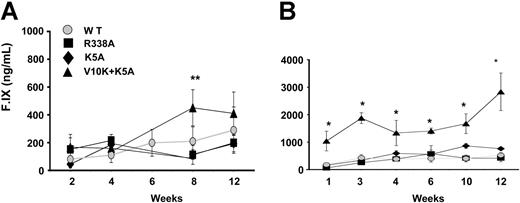
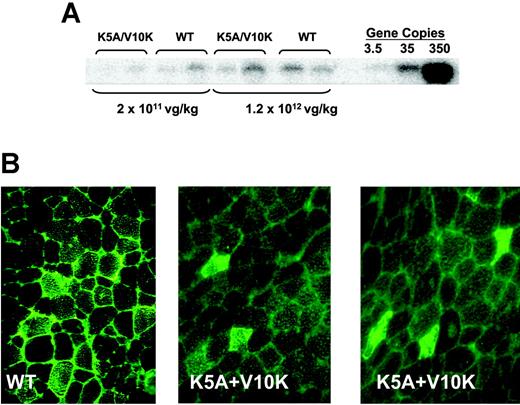
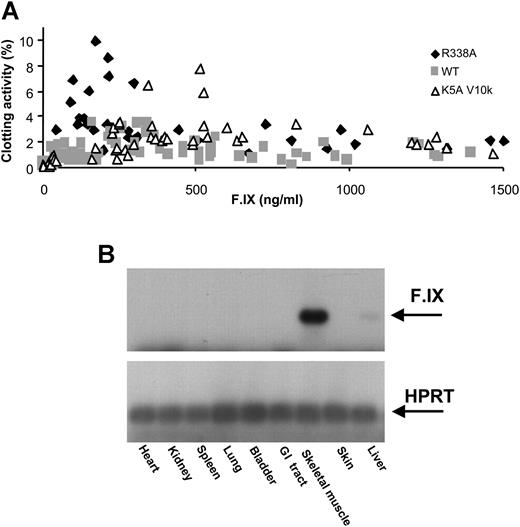
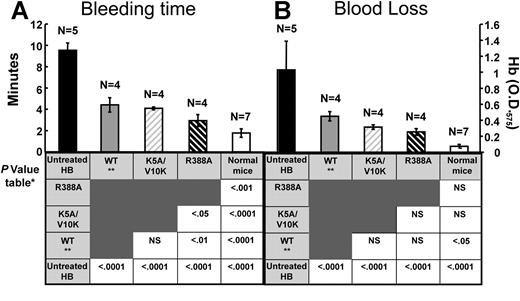
![Figure 6. Human F.IX expression as a function of time and anti-F.IX antibody measurements. (A) Transgenic mice tolerant to human wild-type F.IX received AAV vectors encoding F.IX-WT (▴) or variants (K5A [], K5A/V10K [▪], R338A [×]) at a dose of 1 × 1012 vg/kg by intramuscular injections. Skeletal muscle-derived F.IX levels determined by ELISA are detectable in plasma samples collected 2 weeks after injection and throughout the duration of the experiment. Immunodeficient mice (*; CD4 knock-out mice) as a control group presented similar increase in circulating F.IX after intramuscular injection of AAV-F.IX-WT. When the same vector was administered to normal C57BL/6 (nontolerant [•]) mice, no F.IX was detected after 4 weeks of injection. (B) Detection of specific IgG1 antibodies to F.IX-WT (▪) or variants K5A (▦) or R338A (□) at 4 weeks after vector injection were restricted to nontolerant C57Bl6 mice. The numbers of animals tested are indicated. Data shown are mean values ± SD.](https://ash.silverchair-cdn.com/ash/content_public/journal/blood/105/6/10.1182_blood-2004-08-2990/6/m_zh80060575820006.jpeg?Expires=1769345217&Signature=D8LHX1lnaIJkTyTLOlAmzNvCIR2bCymdyEKs9RucMbuhQ9i6rhKdFt9T9LgLSOwgWhXlHgjvh-qlquqqBdnRhhaEzUhhY5oSzze4fJpe1VnojK0ibzdkXnFDOCt23IHA9CnyxscoScd581~g9o0P-7oY0bshgxmTFpHKNDrGFEkbQakdg~opvN-Igce3rE1Llv9FVFK-Iv3utAYJpO7WO~QyJbDHTZ0wOS8BwFOa478A2bkbnM6FfDGPujaNHKDbfwJRHcUV4ZzDDQKTmwUc6OPhb-mGkkhGGYRwjQuG0HbdmhJBiDkUknNddglku4P5ZENhHA5iPbTb8yt4o1JAGg__&Key-Pair-Id=APKAIE5G5CRDK6RD3PGA)
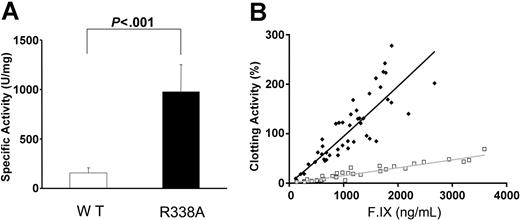



 ), the F.IX variants K5A (
), the F.IX variants K5A ( ), K5A/V10K (▴), or R338A (▪). Vector was injected at doses of 2 × 1011 vg/kg (A) or 1.2 × 1012 vg/kg (B) at 6 intramuscular sites in the hind limbs. Each line represents average values for the cohort (n = 4 mice). Markers represent mean values (± SD). *P ≤ .002 and **P ≤ .05 of comparison between F.IX-WT and F.IX-K5A/V10K groups.
), K5A/V10K (▴), or R338A (▪). Vector was injected at doses of 2 × 1011 vg/kg (A) or 1.2 × 1012 vg/kg (B) at 6 intramuscular sites in the hind limbs. Each line represents average values for the cohort (n = 4 mice). Markers represent mean values (± SD). *P ≤ .002 and **P ≤ .05 of comparison between F.IX-WT and F.IX-K5A/V10K groups.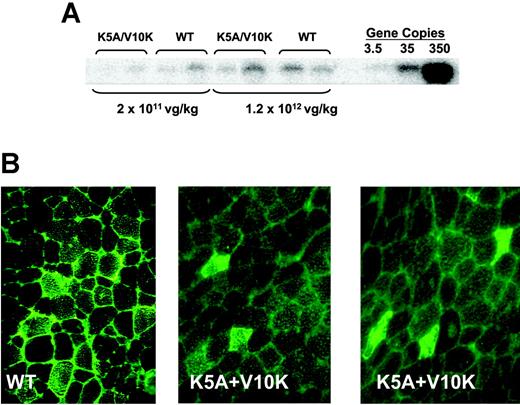
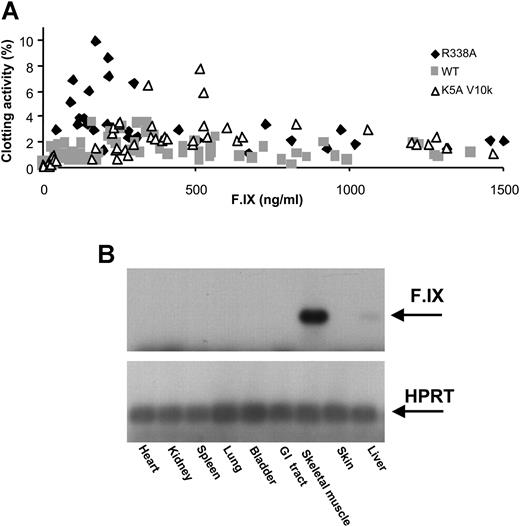
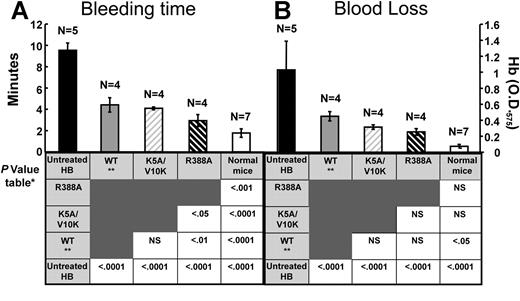
![Figure 6. Human F.IX expression as a function of time and anti-F.IX antibody measurements. (A) Transgenic mice tolerant to human wild-type F.IX received AAV vectors encoding F.IX-WT (▴) or variants (K5A [], K5A/V10K [▪], R338A [×]) at a dose of 1 × 1012 vg/kg by intramuscular injections. Skeletal muscle-derived F.IX levels determined by ELISA are detectable in plasma samples collected 2 weeks after injection and throughout the duration of the experiment. Immunodeficient mice (*; CD4 knock-out mice) as a control group presented similar increase in circulating F.IX after intramuscular injection of AAV-F.IX-WT. When the same vector was administered to normal C57BL/6 (nontolerant [•]) mice, no F.IX was detected after 4 weeks of injection. (B) Detection of specific IgG1 antibodies to F.IX-WT (▪) or variants K5A (▦) or R338A (□) at 4 weeks after vector injection were restricted to nontolerant C57Bl6 mice. The numbers of animals tested are indicated. Data shown are mean values ± SD.](https://ash.silverchair-cdn.com/ash/content_public/journal/blood/105/6/10.1182_blood-2004-08-2990/6/m_zh80060575820006.jpeg?Expires=1769345218&Signature=qYIjJdBlwZ02TIFlpQnhGBdu8ioPBUQPyZ8zf~e-05NhSFpqsKn6yoNQFzKfHHdEiLkhu1PZ9uSjUigD4-iTHrJgu7aNpvcA6y5EvJiFvWyhkb7V7HhpL1f4d~B~uib2DqBXkwXLcrBz0n7nL3NnWyx2UmniyVTNmKyshBHpZFjtyOvhbFEqs9TfP4zHfsxLsZ-BSgFschUnhzZSHRPRcFuTgRo3U4epLYpxXW816IFJ2zwC~O49raasBrKzWwMwIxuKouXjQKMaZCAy8Gcl03oMIvCqQXVi1Tre8XsEFZlFJ2teOFa~H3NsOgUd-iziH~DMxZSXbYRp8nHHG2MleQ__&Key-Pair-Id=APKAIE5G5CRDK6RD3PGA)
